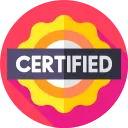FREE
daily Instructor: Dr. onald CookCourse Overview
Grape Varietal Selection and Vineyard Management
Grape Varietal Characteristics
- Comprehensive study of major wine grape varietals (e.g., Cabernet Sauvignon, Merlot, Pinot Noir, Chardonnay, Sauvignon Blanc, Riesling), including their origins, genetic profiles, and typical flavor profiles.
- Analysis of lesser-known varietals and their potential in different climates and winemaking styles (e.g., Petit Verdot, Malbec, Gewürztraminer, Viognier).
- Understanding grape morphology, including berry structure, skin thickness, and seed characteristics, and their impact on wine quality.
Vineyard Site Selection and Preparation
- Detailed examination of terroir components: climate (macro, meso, and microclimate), soil composition, and topography.
- Soil analysis techniques, including assessing pH, nutrient levels, water-holding capacity, and drainage.
- Vineyard layout and row orientation to maximize sunlight exposure and airflow, minimizing disease risk.
- Cover crop selection and management for soil health, erosion control, and nutrient cycling.
Viticultural Practices
- Pruning techniques: cane pruning, spur pruning, and their impact on vine vigor and yield.
- Canopy management techniques: leaf removal, shoot positioning, and hedging to optimize sunlight penetration and airflow.
- Irrigation strategies: deficit irrigation, regulated deficit irrigation (RDI), and sustained deficit irrigation (SDI) to control vine stress and berry development.
- Pest and disease management: integrated pest management (IPM) strategies, including biological controls, cultural practices, and responsible use of pesticides and fungicides.
- Monitoring vine health and identifying nutrient deficiencies through visual inspection and tissue analysis.
Harvesting and Grape Maturity Assessment
- Methods for determining optimal harvest timing based on sugar levels (Brix), acidity (pH and TA), and phenolic maturity.
- Sensory evaluation of grapes to assess flavor development and tannin structure.
- Different harvesting methods: manual harvesting and mechanical harvesting, and their impact on grape quality.
- Grape handling and transportation to minimize damage and oxidation.
Winemaking Processes and Techniques
Pre-Fermentation Processes
- Grape crushing and destemming techniques to prepare grapes for fermentation.
- Must adjustments: sugar additions (chaptalization), acid adjustments (acidification or deacidification), and tannin additions to balance must composition.
- Cold soaking: techniques for enhancing color extraction and aroma development in red wines.
- Use of enzymes: pectinase enzymes for juice clarification and color extraction, and glucanase enzymes for reducing viscosity in wines affected by botrytis.
Fermentation Management
- Yeast selection: understanding different yeast strains (e.g., Saccharomyces cerevisiae, non-Saccharomyces yeasts) and their impact on fermentation kinetics and flavor development.
- Fermentation vessel options: stainless steel tanks, oak barrels, concrete tanks, and amphorae, and their influence on wine style.
- Temperature control during fermentation to manage yeast activity and flavor production.
- Monitoring fermentation progress: tracking sugar levels, temperature, and alcohol content.
- Managing stuck fermentations: identifying causes (e.g., nutrient deficiencies, high alcohol levels) and implementing corrective actions.
Post-Fermentation Processes
- Malolactic fermentation (MLF): understanding the role of lactic acid bacteria in converting malic acid to lactic acid, reducing acidity and enhancing complexity.
- Racking and lees management: separating wine from sediment (lees) to clarify wine and reduce off-flavors.
- Clarification techniques: fining agents (e.g., bentonite, gelatin, egg white) and filtration methods (e.g., diatomaceous earth filtration, membrane filtration) to remove suspended particles and stabilize wine.
- Stabilization techniques: cold stabilization to prevent tartrate crystal formation, and heat stabilization to prevent protein haze.
Oak Aging and Barrel Management
- Oak barrel selection: understanding different oak species (e.g., French oak, American oak), toast levels, and barrel sizes, and their impact on wine flavor and tannin structure.
- Barrel aging techniques: controlling oxygen exposure, monitoring wine development, and topping barrels to prevent oxidation.
- Barrel maintenance: cleaning, sanitizing, and repairing barrels to ensure their longevity and prevent spoilage.
- Alternatives to oak barrels: oak chips, oak staves, and oak powders, and their impact on wine flavor.
Wine Chemistry and Analysis
Basic Wine Chemistry
- Understanding the major chemical components of wine: water, ethanol, acids (tartaric, malic, lactic, acetic), sugars, phenolics, and volatile compounds.
- The role of pH and total acidity (TA) in wine balance and stability.
- Understanding oxidation and reduction reactions in wine and their impact on color, aroma, and flavor.
- The impact of sulfur dioxide (SO2) on wine preservation and microbial stability.
Wine Analysis Techniques
- Titration methods for measuring acidity (TA) and sulfur dioxide (SO2).
- Spectrophotometry for measuring color density and phenolic compounds.
- Gas chromatography-mass spectrometry (GC-MS) for identifying and quantifying volatile aroma compounds.
- High-performance liquid chromatography (HPLC) for measuring sugars, acids, and phenolic compounds.
- Microscopic analysis for identifying yeast and bacteria.
Sensory Analysis and Wine Evaluation
- Understanding the principles of sensory evaluation and the factors that influence perception.
- Developing a systematic approach to wine tasting and evaluation.
- Identifying and describing wine aromas and flavors using a standardized vocabulary.
- Assessing wine structure: acidity, tannins, alcohol, and body.
- Evaluating wine balance, complexity, and length.
- Recognizing common wine faults and off-flavors.
Wine Spoilage and Stabilization
Microbial Spoilage
- Identifying and preventing microbial spoilage caused by bacteria (e.g., Brettanomyces, Acetobacter, Lactobacillus, Pediococcus) and yeasts (e.g., Zygosaccharomyces).
- Understanding the conditions that favor microbial growth in wine (e.g., pH, sugar levels, oxygen exposure).
- Implementing sanitation protocols to minimize microbial contamination in the winery.
- Using sulfur dioxide (SO2) and other antimicrobial agents to control microbial growth.
Chemical Spoilage
- Preventing oxidation and reduction faults, such as browning, acetaldehyde formation, and hydrogen sulfide (H2S) production.
- Managing volatile acidity (VA) to prevent acetic acid spoilage.
- Preventing cork taint caused by 2,4,6-trichloroanisole (TCA).
Wine Stabilization
- Cold stabilization to prevent tartrate crystal formation.
- Heat stabilization to prevent protein haze.
- Using fining agents and filtration to remove unstable compounds and clarify wine.
- Bottle aging techniques to promote wine development and integration of flavors.
Wine Packaging and Marketing
Bottling and Packaging
- Bottle selection: understanding different bottle shapes, sizes, and colors, and their impact on wine presentation and aging potential.
- Cork selection: understanding different cork types (e.g., natural cork, synthetic cork, screw caps) and their impact on wine preservation.
- Bottling line operation: ensuring proper filling levels, cork insertion, and labeling.
- Packaging materials: selecting appropriate labels, capsules, and cartons to protect wine and enhance its appeal.
Wine Labeling Regulations
- Understanding the legal requirements for wine labeling in different countries and regions.
- Accurately reporting information such as alcohol content, vintage, varietal, and appellation.
- Avoiding misleading or deceptive labeling practices.
Wine Marketing and Sales
- Developing a marketing plan: identifying target markets, defining brand identity, and creating a unique selling proposition.
- Utilizing different sales channels: direct-to-consumer sales, wholesale distribution, and export markets.
- Promoting wine through social media, wine reviews, and wine competitions.
- Understanding wine pricing strategies and market trends.
FlashCards
External Resources
Add-On Features
Expert Instructor
Get live study sessions from experts
Honorary Certification
Receive a certificate before completing the course.
Currency
Sign in to change your currency
I'm not ready to enroll?
Tell us why, because it matters.
Enroll With a Key
Course Benefits
Get a Job
Use your certificate to stand out and secure new job opportunities.
Earn More
Prove your skills to secure promotions and strengthen your case for higher pay
Learn a Skill
Build knowledge that stays with you and works in real life.
Lead Teams
Use your certificate to earn leadership roles and invitations to industry events.
Visa Support
Use your certificate as proof of skills to support work visa and immigration applications.
Work on Big Projects
Use your certificate to qualify for government projects, enterprise contracts, and tenders requiring formal credentials.
Win Partnerships
Use your certified expertise to attract investors, get grants, and form partnerships.
Join Networks
Use your certificate to qualify for professional associations, advisory boards, and consulting opportunities.
Stand Out Professionally
Share your certificate on LinkedIn, add it to your CV, portfolio, job applications, or professional documents.
Discussion Forum
Join the discussion!
No comments yet. Sign in to share your thoughts and connect with fellow learners.
Frequently Asked Questions
For detailed information about our Winemaking Certification course, including what you’ll learn and course objectives, please visit the "About This Course" section on this page.
The course is online, but you can select Networking Events at enrollment to meet people in person. This feature may not always be available.
We don’t have a physical office because the course is fully online. However, we partner with training providers worldwide to offer in-person sessions. You can arrange this by contacting us first and selecting features like Networking Events or Expert Instructors when enrolling.
Contact us to arrange one.
This course is accredited by Govur University, and we also offer accreditation to organizations and businesses through Govur Accreditation. For more information, visit our Accreditation Page.
Dr. onald Cook is the official representative for the Winemaking Certification course and is responsible for reviewing and scoring exam submissions. If you'd like guidance from a live instructor, you can select that option during enrollment.
The course doesn't have a fixed duration. It has 27 questions, and each question takes about 5 to 30 minutes to answer. You’ll receive your certificate once you’ve successfully answered most of the questions. Learn more here.
The course is always available, so you can start at any time that works for you!
We partner with various organizations to curate and select the best networking events, webinars, and instructor Q&A sessions throughout the year. You’ll receive more information about these opportunities when you enroll. This feature may not always be available.
You will receive a Certificate of Excellence when you score 75% or higher in the course, showing that you have learned about the course.
An Honorary Certificate allows you to receive a Certificate of Commitment right after enrolling, even if you haven’t finished the course. It’s ideal for busy professionals who need certification quickly but plan to complete the course later.
The price is based on your enrollment duration and selected features. Discounts increase with more days and features. You can also choose from plans for bundled options.
Choose a duration that fits your schedule. You can enroll for up to 180 days at a time.
No, you won't. Once you earn your certificate, you retain access to it and the completed exercises for life, even after your subscription expires. However, to take new exercises, you'll need to re-enroll if your subscription has run out.
To verify a certificate, visit the Verify Certificate page on our website and enter the 12-digit certificate ID. You can then confirm the authenticity of the certificate and review details such as the enrollment date, completed exercises, and their corresponding levels and scores.
Can't find answers to your questions?
Additional Courses
- 896 Views
- 15 Questions
- 554 Views
- 24 Questions
- 830 Views
- 23 Questions
- 341 Views
- 27 Questions
- 829 Views
- 21 Questions
- 1.3k View
- 24 Questions
- 122 Views
- 25 Questions
- 485 Views
- 22 Questions
Certification Guide

Complete the Course
Begin the course by selecting your experience level in the course content section:
Beginner: Master the material with interactive questions and enough time.
Intermediate: Get certified faster with hints and balanced questions.
Advanced: Challenge yourself with more questions and less time

Earn Your Certificate
To download and share your certificate, you must achieve a combined score of at least 75% on all questions answered.





